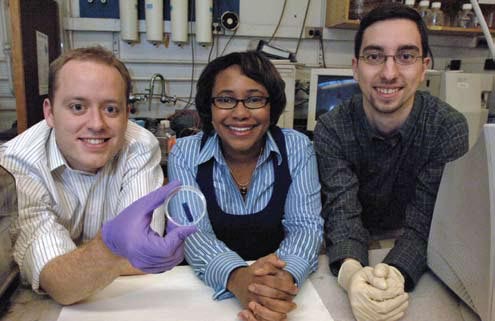An Implantable Pharmacy

Kris Wood, Paula Hammond and Dan Schmidt at MIT (photo – Donna Coveney)
Researchers at Massachusetts Institute of Technology have developed a nanotechnology film that has the potential to deliver drugs for cancer, diabetes, epilepsy and many other conditions “on-demand”. The film can be remotely activated by applying a small electric field and release medication in controlled amounts, possibly in response to embedded sensors in the body. Imagine a whole “pharmacy” of medication customized for a specific patient on a flexible, implantable, biodegradable membrane. The research was recently reported in the Proceedings of the National Academy of Sciences, and is generating interest in many quarters.
The research team, headed by Paula Hammond, the Bayer Professor of Chemical Engineering at MIT, and her team have developed technology for a layered film, typically about 150 nanometers (billionths of a meter) thick, which can be implanted throughout the body. The film is made from a negatively charged pigment (Prussian Blue) and a positively or neutrally charged drug molecule wrapped in a positively charged molecule. The pigment wraps around the drug molecule and fixes it in place. When an electrical current is applied, the Prussian Blue loses its negative charge, which allows the drug to diffuse out into the bloodstream. The amount of drug released, and the timing of release can be controlled very precisely by varying the voltage applied to the film. The film can be made with several layers carrying discrete packets of medication.
The electrical current can be applied remotely using radio waves or other techniques. Initially, the drug release would likely be controlled from outside the body, for example, by a physician at an office visit, or in the emergency department or by an army medic on the battlefield. The system also has the additional potential to link electrical “pacing” the drug release with embedded internal sensors. This could greatly enhance the utility of such a system. One could program the automatic, controlled release of insulin when blood sugar levels get too high, or the timed release of cancer chemotherapy drugs if a particular tumor marker rises in the bloodstream. A soldier might be implanted with film containing nerve antitoxin, pain medications, and/or antibiotics for immediate release if a catastrophic events in combat (or biological warfare) were encountered.
So far, the researchers have only fabricated passive pharmacies-on-a-chip and demonstrated that they can release test-molecules when an external electrical field is applied. Next, the researchers plan to design complete implants with active electronic components and loaded with real drugs that can be tested on animals in clinical trials. Hammond estimates that it will take at least five years before human trials could begin.
Because the films can be constructed layer by layer, the authors say it is easy to control their composition. Potentially many different drugs could be layered in the film. The film can then be coated onto a surface of any size or shape, which offers more design flexibility than other drug-delivery devices such as those made by microfabrication.
The films are easy to mass-produce using a variety of techniques, said Dr.Hammond. These thin-film systems can be directly applied or patterned onto 3D surfaces such as medical implants as well.
Additional contributors to the research include Daniel Schmidt, a graduate student in chemical engineering, MIT PhD recipient Kris Wood, now a postdoctoral associate at the Broad Institute of MIT and Harvard, and Nicole Zacharia, now a postdoctoral associate at the University of Toronto. Stefani Wrightman, a 2006 MIT graduate, and Brian Andaya, a recent graduate of the University of Rochester and summer intern at the MIT Materials Processing Center, are also authors on the paper. The research was funded by the National Science Foundation, the Office of Naval Research and MIT’s Institute for Soldier Nanotechnologies.
More links: